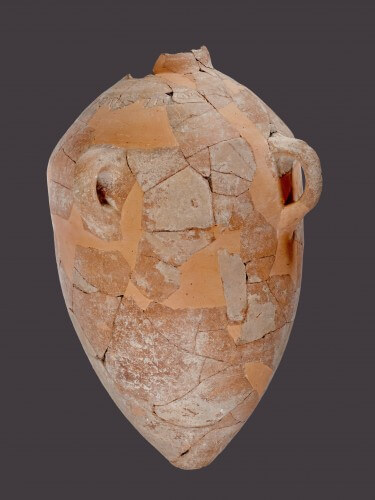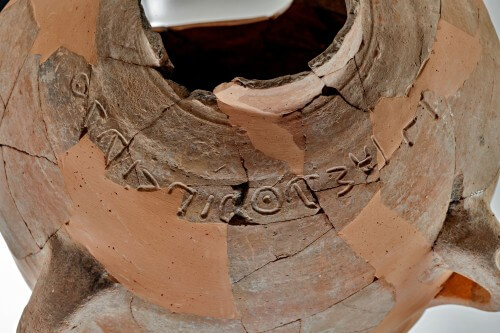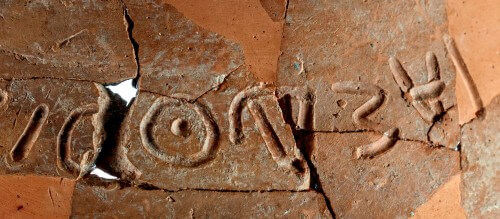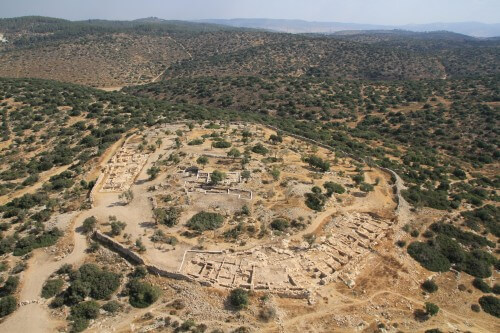Who are you, Ashbaal Ben Bada? - A rare inscription from the time of King David was discovered in the Elah Valley bearing the name of a wine merchant who bore the same first name as the son of Saul who reigned at the same time as David until his murder. This name was used for a very short time * This is the fourth inscription discovered so far from the Kingdom of Judah in the 10th century BC

A rare inscription from the time of King David was discovered in the ruins of Kiapa in the Elah Valley. In excavations conducted at the site by Prof. Yossi Garfinkel from the Institute of Archeology of the Hebrew University and Saar Ganor from the Antiquities Authority, a 2012-year-old pottery jar was discovered in 3,000, broken into pieces. On some fragments it was possible to identify letters in ancient Canaanite script, which ignited the researchers' curiosity.
Intensive forensic work in the Antiquities Authority's discovery laboratories, during which hundreds of pottery shards were glued together into a complete jug, solved the riddle - the inscription was engraved on the jug: Ashbaal Ben Bada. The team of researchers who deciphered the inscription also included Dr. Mitka Golov and Dr. Hagai Meshgav.
According to Prof. Yossi Garfinkel from the Institute of Archeology of the Hebrew University and Saar Ganor from the Antiquities Authority, "This is the first time that the name Ashbaal appears on an ancient inscription in Israel. The Bible recognizes Ashbaal son of Saul, who reigned over Israel at the same time as David. Ashbaal was murdered by assassins, his head was cut off and brought to David in Hebron (10 Samuel chapters XNUMX-XNUMX). It is interesting to note that the name Ashbaal appears in the Bible, and now also in the archaeological find, only in the days of King David, in the first half of the XNUMXth century BC. This name was not used in later periods of the First Temple. The agreement between the biblical tradition and the archaeological find indicates that this name was accepted only during this period. The name Bade is unique, and such a name has not yet been discovered in ancient inscriptions or in the biblical tradition."
According to the researchers, the fact that Ashbaal's name was engraved on a jar suggests that he was an important person. He probably owned a large agricultural estate, and the agricultural produce collected there, was packed and sent in jugs that bore his name. There is evidence here of social stratification and the creation of an established economic status, with the formation of the Kingdom of Judah.
The researchers add that "in the book of Samuel XNUMX they did not like the name Ashbaal, which reminds of the Canaanite storm god Baal, so they changed the original name to Ish-Basheth, but in the Book of Chronicles the original name Ashbaal was preserved. Thus, for example, the name of the commander Gideon ben Yoash was also changed from Baal to Irbeshet.
The ruins of Kiapha are identified with the biblical city of Sha'arim. During several excavation seasons led by Prof. Yossi Garfinkel and Saar Ganor at the site, a fortified city, two gates, a palace and a warehouse building, residential buildings and ritual rooms were uncovered. The city dates back to the days of David: the end of the 11th century and the beginning of the 10th century. Unique finds were discovered on the site that were not known until now. For example, in 2008 the oldest Hebrew inscription in the world was discovered there. Another address, from the same period, is now being published from this website.
According to Prof. Garfinkel and Ganor, "Until about five years ago, there were no known inscriptions at all in the Kingdom of Judah from the 10th century BC. In recent years, four inscriptions have been published: two from the ruins of Kiyapa, one from Jerusalem and one from Beit Shemesh. This situation completely changes the understanding of the circulation of writing in the Kingdom of Judah, and now it turns out that writing was more widespread than previously thought. It seems that the organization of the kingdom required an array of officials and scribes, and this activity is also reflected in the appearance of inscriptions."




20 תגובות
The inscription on the jar from the ruins of Kyapa - another opinion
In 2012, a broken jar was discovered in archaeological excavations in the ruins of Kyapa. Letters in Canaanite script were visible on the fragments, therefore, for two years after that, the parts of the jug were glued together until it was completed. The inscription 'Ashbaal ben Bada' was found on the jug, to the right of the inscription remains of additional letters were seen. which cannot be identified with certainty. The jug was chronologically linked to the dating of the site, to the time of King David.
Once again we witness the connection between an archaeological find and the time of King David. I am sorry that a group of researchers dealing with the ruins of Kyapa. continues to carry the name of King David in vain. while establishing a connection between the archaeological site in Kiyapa and the period of King David, and this according to the carbon 14 dating of a number of olive pits, out of many pits found at the site.
Prof. Finkelstein and Prof. Pisecki published a document called "Kiapha Ruins: Absolute Chronology". The document attacks the average calculation method of dating the site using carbon 14 as done by the researchers of the site. "In the case of the Kyapa ruins, an average calculation is not a legitimate procedure, an average calculation is only justified if there are signs on the site to identify the period, such as burning. Therefore, when dating the site, each test must be considered on its own, without an average calculation." Therefore, the dating of the site is appropriate according to carbon 14 findings for the period between 1130 and 915 BC. A range of dates ranging from Deborah the prophetess to King Rehoboam of Judah.
In the history of the site there is a very important point that is not emphasized enough or does not appear at all, in all the articles published on the site, and that is, the abandonment of the site. A well-fortified city, whose inhabitants will hastily abandon it, leave most of their belongings in their homes, and then it will be destroyed. It is unlikely that an event of this type could have occurred during the time of King David. Therefore, it can be said that the abandonment of the city occurred before the time of King David. Two coffin-like temple models were also found in the ruins of the city. In these temples the main components, the idols, are missing. Since the figurines were not found in the excavations either, it is likely that they were taken with the luggage when leaving the city. And Prof. Garfinkel adds to this, 'the closest example of the (temple) model from the ruins of Kyapa... is the opening of a burial chamber in a magnificent Phoenician tomb discovered at the site of Thamasos in Cyprus' (see - the cult complex near the southern gate in the ruins of Kyapa).
The Bible has an explanation for the abandonment of the city. After the death of Samson the judge, six hundred warriors from the tribe of Dan with their families along with Mekanah and Kuboda, leave their place of residence and move to Lish in the north of the land of Canaan (Judges 6). Since the tribe of Dan lived in Beit Shemesh, still before the establishment of the kingdom of Judah, it can be assumed that he also lived in the settlement in the ruins of Kiyapa. which is 4 km south as the crow flies. Prof. Fawcett writes about the connection between the Kaifa ruins and Beit Shemesh, 'there is a chronological similarity between the Kaifa ruins and layer XNUMX in Beit Shemesh' and later on, 'there were (researchers) who pointed out the similarity between the findings at the (Kiafa) site and the findings dated to the end of the Iron Age at other sites in the Lowland, For example, Beit Shemesh (see - Southern Palestine in the transition from Iron Age I to Iron Age II)
The departure of the tribe of Dan from the area followed pressure from the Philistines, the Philistine city of Azka was found two kilometers west of Kiyapa. The evacuation of the tribe of Dan as written, made it possible for the Philistines to ascend the mountain to the east. And during the reign of David, the Philistines are in the Valley of Refaim south of Jerusalem (and the Philistines came; and they were abandoned, in the Valley of Refaim. Samuel 23:XNUMX, XNUMX). And the governor of the Philistines sits in Bethlehem (David, Oz in the citadel; And the position of the Philistines, Oz the house of Bethlehem. Samuel XNUMX, XNUMX, XNUMX). By the way, Bethlehem is XNUMX km east as the crow flies from the ruins of Kiapha. And for the sum of the passage it can be said that during the time of King David the settlement in Kiyapa was already abandoned and destroyed.
The inscription on the jug - you can see the style of writing the letters. And as a result of that, more or less, the period of the writing on the jug. As it is written on the website Daat - 'in antiquities dating, reserve an important place for checking the writing style (paleography), because each period has its own unique style' (see: The Bible and archeology - tradition versus science, by - Daniel Moshe Levy and Yosef Rothstein).
Since then, the Canaanite script was invented, at the beginning of the second millennium BC. It has gone through several generations of development. The letters on the jug do not correspond in any way to the Canaanite script from the 10th century BC. For example, the letter "S" stands vertically in the inscription, as it is seen in four other inscriptions from the 13th and 12th centuries BC - Zebat Zerte, Halef Malchish, Shalesh Malchish and Kobur El Valida. And starting from the 10th century BC, the letter returns to its natural form, in horizontal writing. The letter "b" in the inscription appears three times upside down, there is no such example in other inscriptions. Except for one, a Canaanite inscription on an arrowhead from the Al-Hadr area, which says "Hatz Abd La(L)t". The inscription dates back to the end of the 12th century and the beginning of the 11th century BC. The letter "a" in the inscription stands vertically, while in the inscriptions from the 10th century BC. The letter is written horizontally.
And it is clear that the inscription on the jar does not correspond to the 10th century BC, it is earlier. I argue against the epigraphers who deciphered the inscription, who did not mention in any article that the style of writing the letters does not chronologically match the dating of the olive pits using carbon 14.
Ashbaal son of Bada - names with the suffix "baal" are distinctly Phoenician names, as we know the kings of Phoenicia: Avivael, Ethbaal, Elibaal, Shepatbaal, Ithubaal, Zecharbaal and one from North Africa, Hannibal. And if I didn't mention someone with him, I'm sorry.
At the time of writing the inscription on the jar, the Canaanite scribe did not yet make use of reading verification. And so the correct name of 'Ashbaal' was actually 'Ishbaal'. Or rather 'husband'. As we see in inscriptions two and three hundred years later. That the word 'Ish' was still written as 'Ash'. Misha King of Moab's inscription - "And Ash Gad dwelt in the land of Ataret Malam" and the man Gad dwelt in the land of Ataret never. And it is written in the Ajrod book - "Anyone who asks a man of Hanan and gives it to him will be his dog."
Most likely the same people who converted the Book of Chronicles into full spelling. They did not want to write that King Shaul had a son, the bearer of the Canaanite name 'Ish-baal', so they left the original name 'Eshbaal'. The name Ashbaal appears in the Bible only once, in a duplicate verse, in the Book of Chronicles.
The name Ashbaal is a Canaanite name. Baal was a Canaanite god.
During the time of David there was a mixed population of Canaanites and Jews/Israelites.
Raphael
OK I got it. I do not see an answer to this in the words of Dr. Yechiam Sorek that my father brought here.
Petzar (coward random combination of letters (I no longer have the strength to keep track of all the nicknames))
Since you are so good at being wrong and enjoy it so much, I am happy to share with you that I am neither Jewish nor a pagan.
Raphael
You don't have to go far. There is at least one idolatrous Jew here who goes by wd 🙂
WD My question is simple - how did he understand that if it was a Jew then he was necessarily an idolater. Unfortunately, it is not possible to say that there are no Jews who worship idols. It is known that in our many sins there were Jews who worshiped idols at that time and even today unfortunately there are.
Raphael
You didn't understand how he came to the conclusion that he was an idolater or you didn't understand how he could say that there is such a thing as an idolater Jew?
I did not understand how Dr. Yechiam Sorek came to this conclusion: "And if it is a Jew, then he was an idolater."
was Created
You get the impression that you really get bored whenever a person tries to interpret findings in a way that seems to him to be most consistent with the truth, according to the evidence. Why?
Yehiam Sorek, you get the impression that you are really shocked every time a finding is discovered that strengthens the Jewish people's attachment to the Land of Israel. Why?
Three thousand years of conquerors trying to exterminate the memory of their predecessors make it very difficult to uncover the evidence. Why do you add sin to crime and refer to the findings in Lilog?
Comment from Dr. Yechiam Sorek: From the article it appears, at least seemingly, some connection between the subject of the inscription and David or Shaul, and from this they seek to confirm the proof of the presence of the Jewish and then the Israeli royal houses. The inscription points to a Canaanite presence and if it is a Jew, then he was an idolater.
This issue is not a little reminiscent of Elad's attempts to prove the Jewish presence in Jerusalem at the beginning of Dana whenever any item of this or that is found in Jerusalem and especially in what is known as the City of David
Thanks
What a question, this is the great-grandfather of the great-great-grandfather of Muhammed al-Balastini
Dear Makloof, you were indeed right and thank you for correcting the error.
From Pibusht, of course, he was not killed by a chariot and a horse, and it even appears later in the book of XNUMX Samuel as it is written: (XNUMX:XNUMX) "And from Pibusht ben-Yonathan ben-Sha'ul came to David, and he fell on his face, and they prostrated themselves; And David said of Phibesheth, and said, Behold your servant."
It still needs to be corrected in the article that no Bashet man was murdered by the order of King David of Israel.
I didn't understand why they count the number of gentiles and not ours?
Dear Arnon - you are right about everything, just not about adding the name in parentheses - from Fibusoth. From Pibusoth there was no other name of a man of shame. The other name of Ish Bosheth was Ashbaal. On the other hand, Mephibosheth is the illegitimate son of Jonathan ben Shaul, i.e. the nephew of Ish Bosheth. Two different people.
Indeed, as Chaim pointed out - no one says that the name found written on the urn is Ish Bushet ben Shaul.
The reason Ashbaal ben Shaul (a man of shame) was mentioned is to point out that there is only one place in the Bible that this first name is mentioned - in the days of David, and there is only one non-biblical source in which this name is found - the jar from the price of Caiaphas, which is also dated to the days of David. Hence the admiration. In order to prove from this find the existence of the Kingdom of Judah, we need a few more crosses (I think there are - the style of the city structure, bone finds, types of worship).
Ashbaal is like the name of Ben Shaul - just as Binyamin is like the name of the Prime Minister - but not everyone named Binyamin is the Prime Minister. What is so complicated? And it says Ashbaal son of Bada - not son of Shaul. They only say that the same Ashbaal lived in the time of David.
I agree with the above commenters. A man from Bushet (or from Fibusht) was murdered by a car and tortured by the sons of Ramon the Barothite, because they wanted to please King David. But David was not only not happy about his death, but was also very sad because "they killed a righteous man in his house - on his bed" and so he ordered his boys to kill these two murderers and cut off their limbs and hang them over the pool (meaning that they will be food for the birds of the sky) for eternity .
Saul's son was not killed by David's order. The opposite is true David regretted his death and killed his murderers
Two minor corrections regarding the summary - first of all, we don't know that he was actually a wine merchant (also not mentioned in the article), and if we mention the biblical Ashbaal, according to the story he was eliminated not by the order of David, who even executed the exterminators